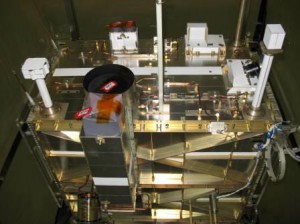SO-67 (Sumbandilasat)
Partial recovery possible Amateur Radio Operation may resume in March 2012
“We have not given up on our efforts to get SumbandilaSat working again even if it is only partially” , said Johan Lochner ZR1CBC who is spending much time on the recovery process and many nights burning the midnight oil working on new and more intelligent algorithms. He and his colleagues are making every effort to get the satellite working again.
 “SumbandilaSat experienced a corruption in the programme memory of one of the power switches. This is the interface unit which controls a robust orientation control implementation system which is using output from the magnetic sensors to point the solar panels towards the sun in a safe mode scenario when for example communications with the ground segment was not possible for a few days or when another anomaly occurs in the software or hardware functioning of the satellite.”
“SumbandilaSat experienced a corruption in the programme memory of one of the power switches. This is the interface unit which controls a robust orientation control implementation system which is using output from the magnetic sensors to point the solar panels towards the sun in a safe mode scenario when for example communications with the ground segment was not possible for a few days or when another anomaly occurs in the software or hardware functioning of the satellite.”
The corruption of the program memory prevented the magnetic interface unit from automatically switching on after power-up and thus preventing access to measurements taken by the magnetometer.
Magnetic orientation readings are needed for implementing orientation control algorithms in other parts of the satellite. The inclusion of this unit was to implement a simple, low power orientation system that in an emergency situation would point the satellite towards the sun and also provide sensor data to the rest of the satellite where it is needed for more complex orientation controls, for example acquiring images or down linking data over a ground location.
“In the past the automatically switching on of the magnetic interface unit gave us the ability to recover the operation of the satellite after an anomaly had occurred and re-start operations. This was several times illustrated in May and June last year when ground segment engineers were able to restart the amateur radio payload”, Johann said
“As a result of the malfunction of the magnetic control unit the satellite started to slowly point away from the sun with intermittent sun eclipses. When there was no power flowing from the solar cells the batteries drained and we could not in a safe way communicate with the satellite, so we backed off. Once we determined this pattern we stopped communicating with the satellite when we did not see sufficient charge on the batteries At other times we had good communication when could diagnose what was going on. During good communication windows that could last 2 or 3 days we tried to diagnose the exact nature of the problem in the same way as we had done before and we started to implement a fix. The particular power switch that failed was already the redundant one so we were in a worse state than before.”
“We tried in many ways to access the power switch though the back door by catching it in the boot loader where there is a small window of opportunity.”
“Despite man efforts we were not able to access the failed secondary power switch node, even with automated poling after every power up and throughout normal operation of the satellite we could not access the power switch in the boot loader.”
“We decided to implement automated ground segment software to make contact with SumbandilaSat from both SANSA Space Operations and the Electronic Systems labs at SU. The objective s was to contact the satellite automatically and to try to implement the recovery procedure and also notify us if any contact was made.”
“Mid November 2011 we again made contact with SumbandilaSat and set in place a planned recovery procedure. Within 3 -4 days we came to the conclusion that the main battery had failed. Earlier the intermittent contact was because the battery could not be fully charged and that satellite power bus was too low for the processors and transmitter to function. “
“We surmised that during the month that we had no contact that the battery must have gone open circuit. With the battery no longer on the power bus, the voltage on the bus would rise to 28.5 and supply enough current to support operations when SumbandilaSat was in full sunlight.
At this stage we cannot solve the flash programmer corruptions. But who knows?
Although the orientation control unit cannot be accessed it will still be possible to support some of the operations even the downloading of imagery. The South African Department of Science and Technology, who owns the satellite, has said that the main payload mission has ended. Ground station engineers are continuing working wit SumbandilaSat. So far all the checks of the systems required for the amateur radio operations are positive so there is no reason why it cannot be reactivated.
“To do this in a more manageable and predictive way we need to upgrade the software for the satellite to manage its power in a different way and log telemetry better to manage the situation, We are working on an intelligent algorithm with an intelligent processing requirement to monitor the power bus.
“We are determined to get this working and to maintain the scientific value of the satellite as much as possible. My focus is now on getting the amateur radio transponder working which with the loss of OA51 will be a great asset to amateur radio satellite activity”’ Johan said. “By the end of February we hope to achieve this!”
Uplink: 145.875 MHz FM (no tone required)
Downlink: 435.345 FM MHz
[PE0SAT Thanks SA-AMSAT for the above information]
